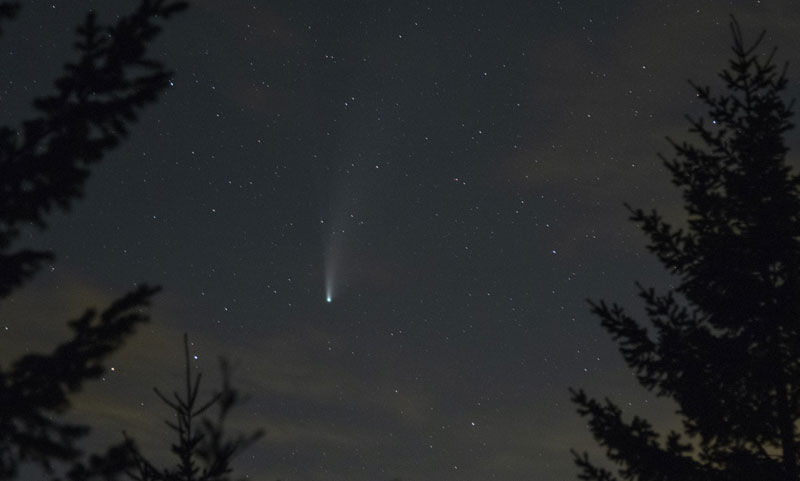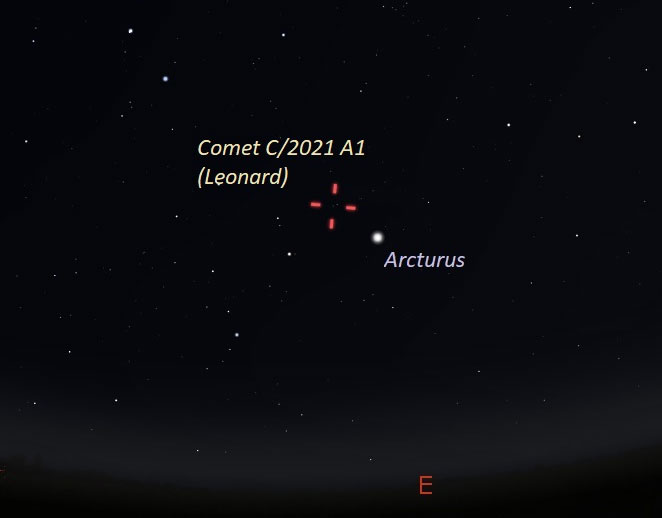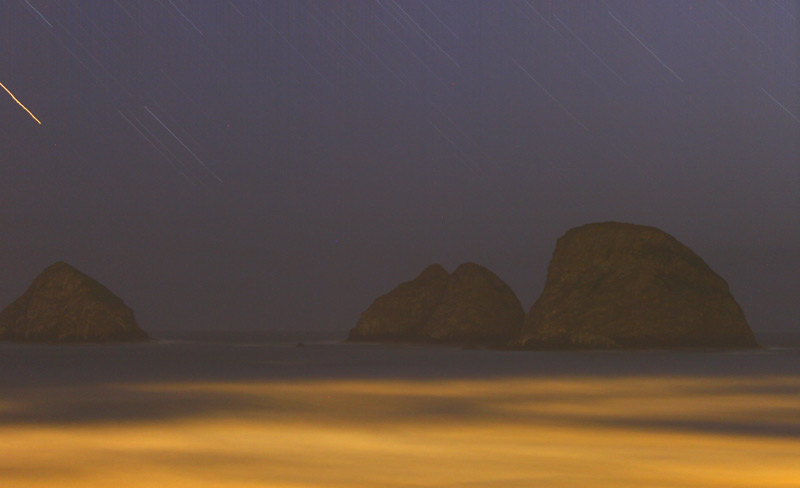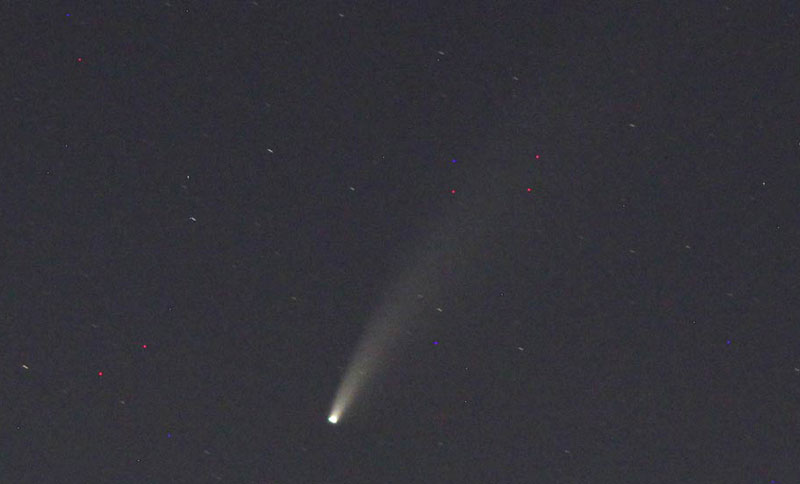New Comet May Be a December Star for Oregon Coast, Washington Coast
Published 12/03/21 at 5:22 AM PST
By Oregon Coast Beach Connection staff

Includes exclusive listings; some specials in winter
In Cannon Beach:
Includes rentals not listed anywhere else
In Manzanita, Wheeler, Rockaway Beach:
Some specials for winter
In Pacific City, Oceanside:
Some specials for winter
In Lincoln City:
Some specials for winter
In Depoe Bay, Gleneden Beach:
Some specials for winter
In Newport:
Look for some specials
In Waldport
Some specials for winter
In Yachats, Florence
Some specials for winter
Southern Oregon Coast Hotels / Lodgings
Reedsport to Brookings, places to stay; winter deals
(Manzanita, Oregon) – An unearthly visitor may be showing up in the skies of the Oregon coast and Washington coast in December. In fact, it's already in the vicinity of Earth – in the cosmic sense - but you just can't see it with the naked eye. (Photo above of Comet Neowise in southern Oregon, courtesy Bureau of Land Management)
Yet.
At least that's the hope for what is known as Comet Leonard, actually called Comet C/2021 A1. Scientists are saying it's quite possible it will start glowing bright enough to be seen without the aid of optics. Even then, however, it will just be a faint, fuzzy star to human eyes, not unlike Comet Neowise was back in 2020.
It certainly has OMSI astronomy expert Jim Todd excited. (See a photo of the comet)
“It still might become the brightest comet of 2021,” he said.
Comet Leonard only recently acquired a glowing tail, after being discovered in January of this year by astronomer Greg Leonard. It's slowly making its way closer to the sun, which causes the ball of ice and gas to grow brighter when its material is heated up by that close encounter with our star. As it reaches perihelion (the closest to our sun), comets like this typically hit their brightest illumination. It makes perihelion on January 3, 2022, which numerous scientists believe will make it a bit of a Christmas spectacle, according to NASA.
“Leonard was discovered as a faint smudge in January 2021 when it was out past Mars - but its orbit will take the giant shedding ice-ball into the inner Solar System, passing near both Earth and Venus in December before it swoops around the Sun in early January 2022,” NASA said. “Although comets are notoriously hard to predict, some estimations have Comet Leonard brightening to become visible to the unaided eye in December.
“Comet Leonard was captured just over a week ago already sporting a green-tinged coma and an extended dust tail.”

Courtesy EarthSky.org
NASA said Comet C/2021 A1 is traveling so quickly it will change position daily throughout this month. It's already shifting from being seen in the morning skies to evening skies now. On December 5, for example, it will be very close to the star called Arcturus. Then it will be a ways away the next evening.
On December 12 it makes its closest pass to Earth, which is still some 21 million miles away. When it reaches perihelion it will begin to swing around the sun at 54 million miles from it.
Todd said you'll need a dark sky to view it, which the Oregon coast and Washington coast will have plenty of during the month – weather permitting. However, given the fantastic images caught by photographers along the Oregon and Washington coastlines with Comet Neowise last year, it will be a good portent – photographically. If Comet C/2021 A1 winds up even as faint as Neowise was to the naked eye, it will create some artistic wonders along these shorelines.
Scientists are using what's known as orbital calculations to figure the comet's path through our solar system, and the bad news is it takes thousands of years for it to swing back again.
In the meantime, scientists say right now is a great time to catch the comet with binoculars or telescopes. If you've got a fancy camera system that connects to a telescope, the Oregon coast and Washington coast will be among the prime spots to shoot even now, considering the lack of light interference.
Todd promised more updates for Oregon and Washington soon.
Oregon Coast Hotels for this event - South Coast Hotels - Where to eat - Maps - Virtual Tours
Cannon Beach Lodging
Nehalem Bay Lodgings
Manzanita Hotels, Lodging
Three Capes Lodging
Pacific City Hotels, Lodging
Lincoln City Lodging
Depoe Bay Lodging
Newport Lodging
Waldport Lodging
Yachats Lodging
Oregon Coast Vacation Rentals
Oregon Coast Lodging Specials
Movement of the stars and moon at Manzanita

Star movement at Oceanside

Comet Neowise - Oregon Coast Beach Connection
More About Oregon Coast hotels, lodging.....
More About Oregon Coast Restaurants, Dining.....
LATEST Related Oregon Coast Articles
Happy ending for the elephant seal with tales from Oceanside to Long Beach. Marine sciences
Winema Wayfinding Point or Pacific Crest Wayside: an Oregon Coast Puzzle
Between Neskowin and Pacific City sits a viewpoint with two names. Travel tips
Oregon Wildlife Experts: Leave Animal Babies Alone in Forests, Coast
People with the right intentions can do the worst. Marine sciences
Authorities Seek Suspect Who Stabbed Baby Seal on Oregon Coast
Attack happened in Neskowin: see the police drawing. Weather
Cannon Beach Sandcastle Contest 2025: N. Oregon Coast Tradition Happens June 21
Started in '64 after a tsunami hit town. Newport events Manzanita events, Cannon Beach events, Seaside events, Astoria events
Florence Rhododendron Festival Hits Florence and Central Oregon Coast Soon
May 15 to 18, food vendors, a carnival, parades and even a classic car cruise. Florence events, Newport events Manzanita events, Cannon Beach events, Seaside events, Astoria events
Oregon's Tillamook Coast Hosts Rigorous Kayaking, Hiking Events in May
Netarts events May 17 and 31; Manzanita events May 14
Above Oregon / Washington Coast in May: Meteors Peak, Galaxy Disappears - and...
A sky full of possibilities this month, including a star that might explode. Sciences, astronomy
Back to Oregon Coast
Contact Advertise on BeachConnection.net
All Content, unless otherwise attributed, copyright BeachConnection.net Unauthorized use or publication is not permitted




















































